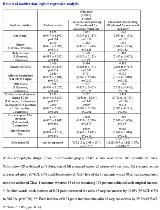Phase-Amplitude Coupling Between Interictal High-Frequency Activity and Slow Wave in Epilepsy Surgery
Abstract number :
1.132
Submission category :
3. Neurophysiology / 3A. Video EEG Epilepsy-Monitoring
Year :
2018
Submission ID :
493876
Source :
www.aesnet.org
Presentation date :
12/1/2018 6:00:00 PM
Published date :
Nov 5, 2018, 18:00 PM
Authors :
Hirotaka Motoi, Children’s Hospital of Michigan, Wayne State University, Detroit Medical Center; Makoto Miyakoshi, University of California - San Diego; Taylor J. Abel, Hospital for Sick Children; Jeong-Won Jeong, Children’s Hospital of Michig
Rationale: We hypothesized that the modulation index (MI), a summary measure of the strength of phase-amplitude coupling between high-frequency activity>150 Hz and the phase of slow wave3-4 Hz, would serve as a useful interictal biomarker for epilepsy presurgical evaluation. Methods: We investigated 123 patients who underwent focal cortical resection following extraoperative electrocorticography recording and had at least one-year of postoperative follow-up. We examined whether consideration of MI would improve the prediction of postoperative seizure outcome. MI was measured at each intracranial electrode site during interictal slow-wave sleep. We compared the accuracy of prediction of patients achieving ILAE Class-1 outcome between the full multivariate logistic regression model incorporating MI in addition to conventional clinical, seizure-onset zone (SOZ), and neuroimaging variables and the reduced logistic regression model incorporating all variables other than MI. Results: Ninety patients had Class-1 outcome at the time of most recent follow-up (mean follow-up: 5.7 years). The full model had a noteworthy outcome predictive ability, as reflected by regression model fit R2 of 0.409 and area under the curve (AUC) of receiver operating characteristic plot of 0.838. ‘Incomplete resection of SOZ (p<0.001)’, ‘larger number of AEDs at the time of surgery (p=0.007)’, and ‘larger MI in non-resected tissues relative to that in resected tissue (p=0.020)’ were independently associated with a reduced probability of Class-1 outcome. The reduced model had a lower predictive ability as reflected by R2 of 0.266 and AUC of 0.767. Anatomical variability in MI existed among non-epileptic electrode sites, defined as those unaffected by MRI lesion, SOZ, or interictal spike discharges. With MI adjusted for anatomical variability, the full model yielded the outcome predictive ability of R2 of 0.422, AUC of 0.844, and sensitivity/specificity of 0.86/0.76. Conclusions: MI during interictal recording may provide useful information for prediction of postoperative seizure outcome. Funding: NIH grants NS047550, NS064033

.tmb-.jpg?Culture=en&sfvrsn=89cac108_0)